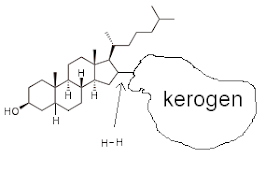Short version: Sponges evolved before the end of the Marinoan “Snowball Earth” glaciation, and were common from then through the Ediacaran and into the Cambrian.
How they did it:
As anyone who is conscious about healthy food knows, animal fat contains lots of cholesterol, while plant fats don’t. This fact has been used for years by people worried about their cardiovascular health. But it also lets us explain the evolution of animal life.
At the risk of slightly oversimplifying, there are three kinds of cholesterol: Good cholesterol, which is found in fit people. Bad cholesterol, which is found in bacon rinds. And 24-isopropylcholesterol, which is found in the cell membranes of certain kinds of sponges.
When organisms die in anoxic environments, the organic remains can sometimes accumulate and alter to form petroleum. 24-isopropylcholesterol is altered by this process to form a similar chemical called 24-Isopropylcholestane. 24-Isopropylcholestane is not known to form in any other way. So Love et al. extracted oil from a bunch of Cryogenean and Ediacaran sediments, fed it through their fancy mass spectrometer, and identified lots of 24-Isopropylcholestane.
Of course, oil can migrate- the gasoline in your car migrated from its source rock to a reservoir, and then to a well, to a supertanker, and to a refinery, before entering your gas tank via a pump. So the cool thing that these authors did was to use hydropyrolysis to show that the kerogen also contained 24-Isopropylcholestane.
Hydropyrolysis uses hydrogen and heat to break hydrocarbons apart. Kerogen is basically a large, insoluble organic compound of some sort. If a sterane is bonded to that kerogen, it cannot migrate, until broken off in the lab.
Hot hydrogen attacks the bond between the molecule and the kerogen:

to release the molecule:

Love et al. use this to show that the bound hydrocarbon population is similar to the unbound population.
When organisms die, they don’t just leave characteristic bones behind. They also leave molecules. And those molecules can be just as diagnostic as more traditional fossils.
For more details, read the paper. Or see Callan's take.
Gordon D. Love, Emmanuelle Grosjean, Charlotte Stalvies, David A. Fike, John P. Grotzinger, Alexander S. Bradley, Amy E. Kelly, Maya Bhatia, William Meredith, Colin E. Snape, Samuel A. Bowring, Daniel J. Condon, Roger E. Summons (2009). Fossil steroids record the appearance of Demospongiae during the Cryogenian period Nature, 457 (7230), 718-721 DOI: 10.1038/nature07673
No comments:
Post a Comment